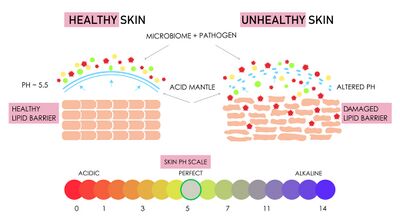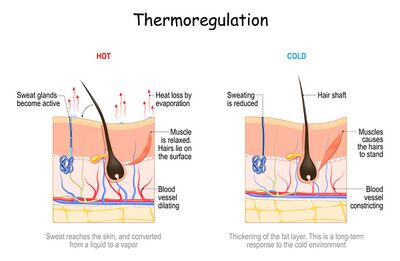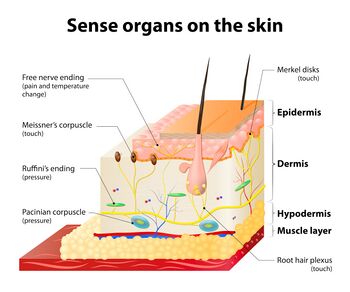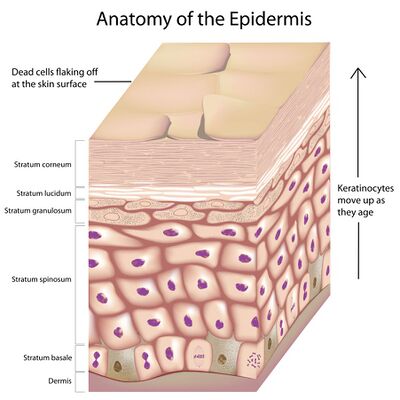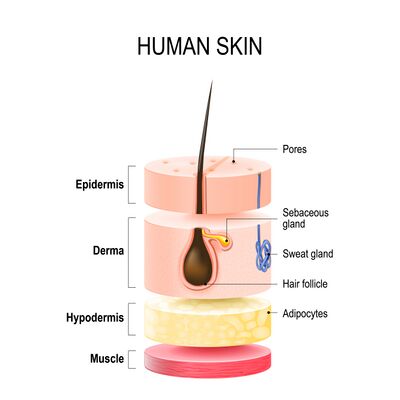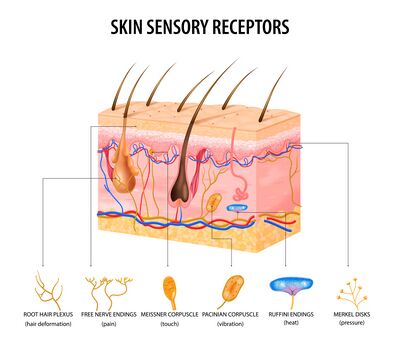Skin Anatomy, Physiology, and Healing Process: Difference between revisions
No edit summary |
No edit summary |
||
| Line 216: | Line 216: | ||
== Chronic Wounds == | == Chronic Wounds == | ||
Chronic wounds are those that do not follow this normal process of healing. They are not closed or making significant progress towards healing in three weeks. | == Chronic Wounds == | ||
Chronic wounds are those that do not follow this normal process of healing. They are not closed or making significant progress towards healing in three weeks. due to a disruption in the healing process. These are the wounds most likely to be treated in a wound care practice. | |||
The skin microbiome of chronic wounds often tips in favour of the harmful microbiome over the beneficial ones. These microbes can trigger the immune system to attack the body's cells required for healing rather than attacking the invaders. Chronic wounds may become stuck in one or more phases that persists for months or years; the inflammatory phase is the most common phase to be stuck in. It's common for chronic wounds to go through periods of healing, stagnation, regression, and reoccurrence.<blockquote>'''Chronic wounds typically have one or more of the following characteristics:''' | |||
There are five most common types of chronic wounds that you're likely to encounter. Those are venous insufficiency wounds, and those are the most common type of chronic wound that you're going to encounter in the clinic setting. Next are neuropathic wounds, related to diabetic neuropathy. Pressure injuries, these are formerly known as pressure ulcers or decubitus ulcers. Arterial ulcers, and then non-healing surgical wounds. And the non-healing surgical wounds typically have a lot of those previous things that we just talked about, like multiple co-morbidities or medications or what have you. | * They have a multifactorial aetiology. | ||
* That person has advanced age or obesity, they've had a previous wound, injury or surgery, especially in the same area. | |||
* Multiple co-morbidities, particularly vascular diseases, diabetes, or auto-immune conditions. | |||
* Prolonged standing or dependency. So that's going to change the ability of blood flow return to their hearts. | |||
* Mechanical forces or recurrent trauma, maybe that's from their shoe rubbing or something else that's pressure. | |||
* Poor tissue perfusion or oxygenation. | |||
* Medications that they are on can affect their wound healing, inadequate or inappropriate care, malnutrition, that's a big one that's often overlooked. | |||
* Active infection, presence of a bacterial biofilm or changes in the skin microbiome. | |||
</blockquote> <blockquote>There are five most common types of chronic wounds that you're likely to encounter. | |||
# Those are venous insufficiency wounds, and those are the most common type of chronic wound that you're going to encounter in the clinic setting. | |||
# Next are neuropathic wounds, related to diabetic neuropathy. | |||
# Pressure injuries, these are formerly known as pressure ulcers or decubitus ulcers. | |||
# Arterial ulcers, and then non-healing surgical wounds. | |||
# And the non-healing surgical wounds typically have a lot of those previous things that we just talked about, like multiple co-morbidities or medications or what have you. | |||
</blockquote> | |||
== Resources == | == Resources == | ||
Revision as of 20:41, 12 June 2022
Top Contributors - Stacy Schiurring, Jess Bell, Kim Jackson and Lucinda hampton
Introduction[edit | edit source]
Our skin, part of the integumentary system, is the largest organ system in the human body. However, it is often overlooked and under appreciated for the role it plays in overall health.[1] Many people only consider the role skin plays in our appearance and how we are perceived by the society. Facial expressions are an important form of non-verbal communication and can have a strong social influence.[2] While our skin is an important part of our outer appearance, it provders a greater contribution to human life and wellbeing than just aesthetics.[1]
This article will overview the anatomy and physiology of skin, skin's response to injury, normal tissue healing, the phases of acute wound healing, and the altered healing in chronic wounds.
Wound healing is complex and involves the coordination of many intricate processes. There are many factors that can impact wound healing, both positively and negatively.
The Role of the Skin[edit | edit source]
Skin provides numerous functions vital to life and is important for overall health.[1]. Skin's health and appearance can be an indicator of general health, and skin integrity failure often accompanies the failure of other organ systems within the body.[3]
8 Key Functions of the Skin[1]:
- Protection: Skin acts as a physical barrier to the external environment and provides protection for internal organs against external threats[1][4]
- Immune function: Our skin contains a protective acidic barrier called the acid mantle. This acidic layer has a pH between 4.2 and 6.0 and this creates a hostile environment for harmful invading organisms while maintaining a favourable environment for beneficial microbes.[1] The acid nature of skin is a key requesite for healthy skin. Skin pH can affect the synthesis and maintenance of a competent skin barrier, play a role in skin pigmentation, and ion homeostasis.[5] Skin pH tends to be lower in people with darker skin because melanin byproducts are acidic and skin pH also tends to increase slightly as we age, which can contribute to an increase in the risk of infection and alter our healing ability.[1].
Specific immune cells and proteins contained in the dermis which activate the immune response and attack invading microbes. These cells include: Langerhans cells, memory T cells, and lymphoid cells.[4]
The surface of our skin houses millions of bacteria, fungi and viruses that compose the skin microbiome and serves as a physical barrier to prevent the invasion of pathogens. As in our gut, the skin microbiome plays essential roles in the protection against invading pathogens, the education of the immune system,[6] and contributing back to the pH of the acid mantle.[1] - Thermoregulation: Humans, and all mammals, can maintain a stable core body temperature via thermoregulatory responses. By increasing blood flow to the skin through vessel dilation, body temperates are lowered by evaporative cooling of moist/sweaty surfaces to release body heat. [1][7] However, if water lost to evaporative cooling is not replaced, body fluid homeostasis will be challenged.[7]
- Prevention of fluid loss: In addition to the physical barrier provided by skin, it also contains lipids, proteins, amino acids, and salts that work to maintain internal body homeostasis by attracting and holding onto water. Due to this mechanism, under normal circumstances, the outer layer of our skin is about 30% water.
- Synthesis of vitamin D: Vitamin D is recognized as a prohormone, also known as calciferol. There are two major forms of vitamin D: D2 which is human-made and fortified into foods (such as milk cheese, yogurt, cereals, and juices) and D3 which is synthesized by the skin and from eating animal-based foods (fatty fish, fish liver oil, and egg yolk).[8]. While vitamin D can be ingested through food or supplements, the skin and exposure to sunlight is the body's primary source of vitamin D.[1] Vitamin D is essential for calcium and phosphate absorption, bone formation, renal function, and our immune function.[1] [8]
- Protection from ultraviolet radiation: Ultraviolet radiation (UVR) can cause DNA photodamage, sunburn, and cause both local and systemic immunosuppressive properties.[9] Melanin and carotene give skin its colour and serve to reflect UVR as a protective mechanism to radiation damage.[1] Melanin also has antioxidant and radical scavenging properties.[9] Melanin is produced by melanocytes in response to increased sunlight, which is why populations that evolved in areas with more sun exposure tend to have darker skin.[1]
- Interaction with the environment: Our skin gathers sensory information through free nerve endings, hairs, receptors to touch, temperature, pain. In addition, through physiological processes like sweating or blushing, information is shared about our internal state to the outside world.[1]
- Healing: Tissue restoration in response to injury.[1]
Please view the following short optional video for an overview of the roles and functions of the skin.
Skin Anatomy and Physiology[edit | edit source]
It's important to understand the layers of our skin so that we can understand how healing occurs differently based on depth. The skin has two principle layers, the epidermis and the dermis. The hypodermis is considered an extension of the skin by some sources, but not by others.[1]
The Epidermis[edit | edit source]
- Composed of five layers
- It is avascular
- It's thickness varies based on location, for example it is thickest on the heels and thinnest on the eyelids. Areas that have increased use from friction or weight bearing can build up thicker layers of skin, for example where a pencil rubs your writing finger or shoe rubs against your foot.
- It has no nerves, however free nerve endings from the dermis do extend into the mid layers of the epidermis.
Five layers of the epidermis (most to least superficial):
- Stratum corneum
- Composed of 15 to 30 layers of keratinocytes called squames or corneocytes. These are the dead keratinocytes which contain a high concentration of keratin that provide a waterproof barrier for the skin, hair, and nails.
- This layer is continually being shed from the body. Shed cells are replaced via the process of skin cell migration from the stratum basale. This process takes an average of 30 days, but this will vary by age and certain health conditions. [1]
- Stratum lucidum
- Contains two to three layers of keratinocytes and is not living. It can be penetrated or shaved off without awareness.
- It is only found in areas of thick skin, like the palms of the hand and the soles of the feet. Present in calluses.[1]
- Stratum granulosum
- This layer contains the greatest concentration of free nerve endings that extend from the dermis. Free nerve endings are an unencapsulated dendrite originating from a sensory neuron. They are the most common nerve endings in skin and provide sensory information about painful stimuli, hot and cold, and to light touch, however they are less sensitive to abrupt changes in stimulation.[11]
- This is the most superficial layer of the epidermis which contains living cells.[1]
- Stratum spinosum
- Contains Langerhans cells and lymphocytes which play an important role in the immune system.[1]
- Stratum basale
- Only layer that undergoes continuous mitosis to produce new cells[1]
- Keratinocytes are constantly being produced in the stratum basale and they move up through the layers until they reached the outermost layer.[1] They are the most dominant cell type in the skin and play a critical role in wound healing as both structural cells and via important immune functions. [12]
- Melanocytes are also produced in this layer. They produce melanin, which contributes to the colour of skin. Humans have approximately the same amount of melanocytes, therefore skin colour is based on the amount of melanin that those melanocytes produce in response to their environment.[1]
- Also contains Merkel cells which can perform both nervous and endocrine actions. They can synthesize and store locally produced hormones and neurotransmitters. They function as mechanoreceptors [1] for light and selective tactile perception but not to hard touch and vibration; they are also involved in the transfer of nociceptive signals.[13]
The Dermis[edit | edit source]
- Located deep to the epidermis
- Contains blood vessels and nerves which supplies the epidermis via capillary loops and free nerve endings
- Composed of two layers[1]
Two layers of the dermis (most to least superficial):
- Papillary layer
- Interdigitates with the epidermis
- The ridges of this layer give rise to our unique fingerprints
- Contains fibroblasts which are responsible for the production of collagen, elastin, and proteins. These qualities give skin strength and flexibility.
- Contains mast cells which produce heparin and histamine, important factors in clot formation and the inflammatory response.
- Contains macrophages which play an important role in immune response, wound repair, cancer defense, salt balance, and hair regeneration. They are known for destroying foreign invaders through phagocytosis[1] (the process by which a phagocyte, a type of white blood cell, engulfs and digests foreign cells and removes dead cells[1][14]).
- Contains leukocytes[1] which are crucial to the inflammatory response following an injury to the skin. Leukocytes are essential for clearing infection and normal wound healing.[15]
- Reticular layer
- Located between the papillary layer and the subcutaneous layer or hypodermis
- It is made up of collagen, blood vessels, nerve endings, T-cells, hair follicles and glands
- The hair follicles contain stem cells that produce keratinocytes that will become hair. They play an important role in wound healing by contributing epithelial cells for wound closure.
- The T-lymphocytes are responsible for destroying pathogens and malignant cells
- Nerves located within the dermis detect sensations such as itching, touch, pressure, vibration, pain, and temperature. Injuries that extend into the dermis can be associated with increased pain due to nerve exposure and damage. The vascularisation of this layer helps to protection the nerve endings and can result in less pain than more superficial cuts that don't bleed. There will be an absence of pain if the nerves are completed destroyed and or severed by an injury or burn. This is due to a lack of afferent sensory information coming into the central nervous system interpret resulting in wounds with little to no pain.[1]
The Hypodermis[edit | edit source]
- Located below the dermis and contains subcutaneous tissue.
- It is made up of loose connective tissue, adipose tissue. It is well vascularised and well innervated.
- It helps to attach the skin to the muscles and bones through superficial fascia, and provides insulation and cushioning through fat storage.
Wounds[edit | edit source]
"A wound is an injury that breaks the skin or other body tissue. Wounds can be open, with broken skin and exposed body tissue, or closed when there is damage to tissue under intact skin."[16]
When there's injury to the skin, wounds and tissue loss can be categorised based on their depth and also the tissues involved.
Wound categorization by wound depth:[1]
| Type of tissue loss | Bleeding | Examples | Healing process | Clinical presentation | |
|---|---|---|---|---|---|
| Erosion | loss of the superficial epidermis only, no dermal loss | Unlikely |
|
local inflammatory process and epidermal replacement from keratinocyte migration upward |
|
| Partial Thickness | loss of the epidermis and part of the dermis | Yes |
|
re-epithelialisation as a result of epithelial cell migration from the wound edges towards the centre of the wound |
|
| Full Thickness | loss of both the epidermis and dermis with extension into the subcutaneous tissue | Yes |
|
via secondary intention |
|
Normal Tissue Healing[edit | edit source]
A clear understanding of the normal or expected healing process is important to recognize when improper healing is occurring in a wound. The process of tissue repair is incredibly complex, and involves many body systems and complex mechanisms.
There are four basic mechanisms by which healing takes place:[1]
- Continuous cell cycling
- Normal intact skin is replaced via keratinocyte production in the stratum basale, followed by upward migration through the layers of the epidermis.
- Cell proliferation
- Healthy cells undergo mitosis to repair damage. The new tissue formed through this process is called granulation tissue.
- However, the structure and function of the replaced tissue cannot duplicated but it is similar to the original.
- It results in scarring.
- Regeneration
- This type of healing can be performed by only a few types of tissue in the human body, to include: the liver, kidney, gastrointestinal tract and the epidermis. No other tissue types can heal in this manner.
- This type of healing involves a complete duplication of structure and function.
- Fibroproliferative healing
- This is a form of pathological healing where lost tissue is replaced by a fibrous scar.
- Occurs in deep wounds, persistent inflammation, fibroproliferative diseases
The longer a wound is open, the more significant the residual scar will be. It is important to reduce healing time and provide the patient with realistic expectations.
Four categories of healing/closure:[1]
- Primary intention
- Surgical wounds, made by an incision.
- The tissue is free from contamination with minimal tissue loss.
- These wounds are closed with external force using sutures, staples, adhesive strips or glue.
- The primary mechanism of healing is epidermal regeneration. Scarring should be minimal.
- There should be no complications. Wound healing and closure occurs in about two weeks time.
- Delayed primary intention
- Surgical wounds, made by an incision. However, the wound is left open (did not approximate the wound edges) due to concern about contamination, active infection, or significant tissue loss which could result in the wound reopening (dehiscing).
- The wound is closed with sutures, staples, grafting, or skin flap placement after it has undergone further healing, edema management, infection control/antibiotics, or debridement of debris.
- There is potential for significant scarring if closure is delayed or chronic inflammation sets in.
- Secondary intention
- This is the process that the majority of wound care practice revolve around.
- Wounds extend into the subdermal tissue and heal as a result of the body's inflammatory response, formation of new granulation tissue to fill the empty space, and then closure via re-epithelialisation (migration of new skin cells over the surface of the wound).
- The edges are approximated through wound contraction due to myofibroblasts.
- Wounds typically take weeks to months to close, depending on size and other factors that may complicate the process.
- Partial thickness wounds that heal by re-epithelialisation
- Not often treated with skilled wound care practice.
- Subdermal layers are not involved therefore wound contraction is not required to approximate the wound edges.
- Minimal to no granulation tissue, minimal to no scarring.
- The duration to closure depends on depth, but ranges from one to two weeks.
The body goes through four phases of tissue healing with every wound, regardless of depth or severity. These phases are not consecutive, but they can overlap. Acute wound typically close in about 21 days, however the entire healing process can last up to two years. A wound is considered chronic when healing is disrupted and the wound is still open after four weeks.
Four phases of healing:[1]
- Haemostasis or clot formation
- Blood vessels respond to injury immediately with vasoconstriction to prevent blood loss and further tissue injury.
- Platelets and fibrin arrive at the site to form a clot which creates a temporary barrier to the external environment. Once dry, these clots are what form a scab. The scab is a body's temporary wound dressing that prevents blood loss and provides protection from the outside world while the tissue repair and healing take place underneath.
- This process begins within seconds and it continues for the first 12 hours after injury.
- Inflammatory phase
- This phase involves to destruction any pathogens that may have entered the body, debris and necrotic tissue removal, and the stimulation of new blood vessel growth.
- Neutrophils, mast cells, and macrophages play a big role in this phase.
- The inflammatory phase occurs in the first 24 hours after injury and typically lasts for about one week. It is seen clinically as redness, swelling, heat, and pain. The process is essential to acute wound healing, but can become problematic if it persists for too long.
- Proliferative phase
- This phase of repair is characterised by new blood vessel formation or angiogenesis, connective tissue growth or fibroplasia, new skin cell formation or epithelialisation, and continued cleaning out of any remaining debris.
- Neutrophils, mast cells, and macrophages are still present during this phase, but the most predominant types are fibroblasts and endothelial cells, which are responsible for the growth of granulation tissue and capillaries. Fibroblasts initially produce type three collagen, which tends to be weaker and more disorganised than type one collagen, therefore new tissue growth will be weaker than the original tissue and more susceptible to injury from outside sources.
- Granulation tissue is bright red, beady, vascular tissue that fills in the wound cavity. It's made up of collagen, elastin, and blood vessels.
- Within hours of injury, re-epithelisation begins with upward migration of the existing keratinocytes. Within a few days, the process continues with cell proliferation via mitosis.
- The time it takes for a wound to be considered closed varies based on the circumferential size and also the depth. There will be a visible scar if the wound takes more than three to four weeks to re-epithelialise.
- The proliferative phase begins four to six days after injury and can last from three weeks to two months. The wound may appear closed once it is re-epithelialised, however it is not considered healed until the next phase is complete.
- Remodelling phase
- During this phase, the wound contracts, granulation tissue settles, blood flow returns to pre-injury levels, and the wound tensile strength increases.
- Myofibroblasts are responsible for wound contraction.
- Fibroblasts, myofibroblasts, endothelial cells, and macrophages are the most predominant cells, their numbers slowly decrease as this phase progresses.
- Type three collagen is slowly replaced by type one collagen, which has increased tensile strength.
- The remodelling phase begins about two weeks after injury and lasts up to two years. The wound may appear healed before this process is complete.
- Around six weeks after injury, the wound has about half its ultimate tensile strength. Once the remodelling phase is complete, that injured area will have approximately 80% of its original strength. These timelines are important to keep in mind when treating patients with chronic or repeated wounds.
Chronic Wounds[edit | edit source]
Chronic Wounds[edit | edit source]
Chronic wounds are those that do not follow this normal process of healing. They are not closed or making significant progress towards healing in three weeks. due to a disruption in the healing process. These are the wounds most likely to be treated in a wound care practice.
The skin microbiome of chronic wounds often tips in favour of the harmful microbiome over the beneficial ones. These microbes can trigger the immune system to attack the body's cells required for healing rather than attacking the invaders. Chronic wounds may become stuck in one or more phases that persists for months or years; the inflammatory phase is the most common phase to be stuck in. It's common for chronic wounds to go through periods of healing, stagnation, regression, and reoccurrence.
Chronic wounds typically have one or more of the following characteristics:
- They have a multifactorial aetiology.
- That person has advanced age or obesity, they've had a previous wound, injury or surgery, especially in the same area.
- Multiple co-morbidities, particularly vascular diseases, diabetes, or auto-immune conditions.
- Prolonged standing or dependency. So that's going to change the ability of blood flow return to their hearts.
- Mechanical forces or recurrent trauma, maybe that's from their shoe rubbing or something else that's pressure.
- Poor tissue perfusion or oxygenation.
- Medications that they are on can affect their wound healing, inadequate or inappropriate care, malnutrition, that's a big one that's often overlooked.
- Active infection, presence of a bacterial biofilm or changes in the skin microbiome.
There are five most common types of chronic wounds that you're likely to encounter.
- Those are venous insufficiency wounds, and those are the most common type of chronic wound that you're going to encounter in the clinic setting.
- Next are neuropathic wounds, related to diabetic neuropathy.
- Pressure injuries, these are formerly known as pressure ulcers or decubitus ulcers.
- Arterial ulcers, and then non-healing surgical wounds.
- And the non-healing surgical wounds typically have a lot of those previous things that we just talked about, like multiple co-morbidities or medications or what have you.
Resources[edit | edit source]
- bulleted list
- x
or
- numbered list
- x
References[edit | edit source]
- ↑ 1.00 1.01 1.02 1.03 1.04 1.05 1.06 1.07 1.08 1.09 1.10 1.11 1.12 1.13 1.14 1.15 1.16 1.17 1.18 1.19 1.20 1.21 1.22 1.23 1.24 1.25 1.26 1.27 1.28 1.29 1.30 1.31 1.32 Palmer, D. Skin Anatomy, Physiology, and Healing. Physiotherapy Wound Care Programme. Physioplus. 2022.
- ↑ Crivelli C, Fridlund AJ. Facial displays are tools for social influence. Trends in cognitive sciences. 2018 May 1;22(5):388-99.
- ↑ Sussman C, Bates-Jensen BM, editors. Wound care: a collaborative practice manual. Lippincott Williams & Wilkins; 2007.
- ↑ 4.0 4.1 Naik S. One Size Does Not Fit All: Diversifying Immune Function in the Skin. The Journal of Immunology. 2022 Jan 15;208(2):227-34.
- ↑ Surber C, Humbert P, Abels C, Maibach H. The acid mantle: a myth or an essential part of skin health?. pH of the Skin: Issues and Challenges. 2018;54:1-0.
- ↑ Byrd AL, Belkaid Y, Segre JA. The human skin microbiome. Nature Reviews Microbiology. 2018 Mar;16(3):143-55.
- ↑ 7.0 7.1 McKinley MJ, Martelli D, Pennington GL, Trevaks D, McAllen RM. Integrating competing demands of osmoregulatory and thermoregulatory homeostasis. Physiology. 2018 May 1;33(3):170-81.
- ↑ 8.0 8.1 Ross AC, Taylor CL, Yaktine AL, Del Valle HB. Committee to review dietary reference intakes for vitamin D and calcium. Food and Nutrition Board. 2011 Jun 22.
- ↑ 9.0 9.1 Brenner M, Hearing VJ. The protective role of melanin against UV damage in human skin. Photochemistry and photobiology. 2008 May;84(3):539-49.
- ↑ YouTube. The science of skin | TED-Ed. Available from: https://www.youtube.com/watch?v=OxPlCkTKhzY [last accessed 11/06/2022]
- ↑ Molnar C and Gair J. Concepts of Biology – 1st Canadian Edition. BCcampus. Retrieved from https://opentextbc.ca/biology/ 2015.
- ↑ Piipponen M, Li D, Landén NX. The immune functions of keratinocytes in skin wound healing. International journal of molecular sciences. 2020 Jan;21(22):8790.
- ↑ Abraham J, Mathew S. Merkel cells: a collective review of current concepts. International Journal of Applied and Basic Medical Research. 2019 Jan;9(1):9.
- ↑ National Cancer Institute. Phagocytosis. Available from: https://www.cancer.gov/publications/dictionaries/cancer-terms/def/phagocytosis (accessed 12/06/2022).
- ↑ Soliman AM, Yoon T, Wang J, Stafford JL, Barreda DR. Isolation of Skin Leukocytes Uncovers Phagocyte Inflammatory Responses During Induction and Resolution of Cutaneous Inflammation in Fish. Frontiers in Immunology. 2021;12.
- ↑ Kindred Healthcare. Types of Wounds. Available from: https://www.kindredhealthcare.com/our-services/ltac/conditions/wound-care (accessed 12/06/2022).
